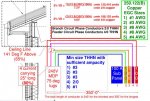That's the difference in cir mil between the required #3 and the upsized conductor.
Nice job Lucky
Quotient, rather than difference.
I think the wording on this rule about proportionally upsizing the EGC has been revised, so that it doesn't apply if conditions of use are the reason for upsizing the wire. It says something along "the minimum size that has sufficient ampacity for the intended installation".
I interpret that to mean the minimum local size of wire, when you neglect voltage drop. And then when you include voltage drop and have to upsize the wire, you upsize the ground proportionally.
For instance, most 100A circuits with copper wire and 75C terminals would require a #3 current-carrying wire, and a #8 ground. If it is in direct sunlight at an 0.82 temperature correction factor, then you would need a #2 wire for the current-carriers. While this is a 26% increase in size from the previous example, it is not a 26% increase in size from the minimum size that has sufficient ampacity for the intended installation. It is no increase from that, and thus the default #8 ground can remain.
However, go back to the example with negligible derate factors. 100A = #3 wire + #8 ground. Now upsize it to #2 because of long distance and voltage drop. Now we have a 26% increase, and thus need a proportional increase in the EGC. 16.5 kcmil for #8 * 1.26 = 20.7 kcmil, which requires #6 ground.



